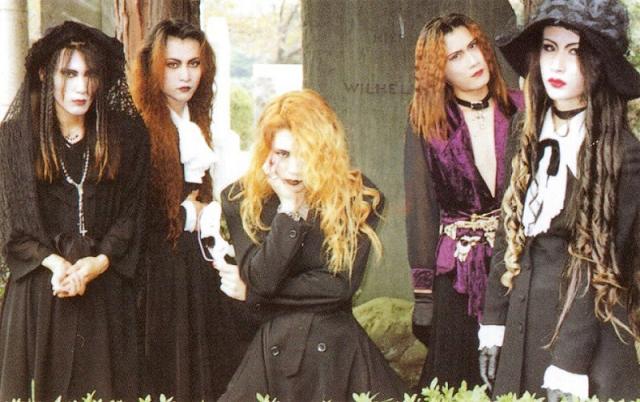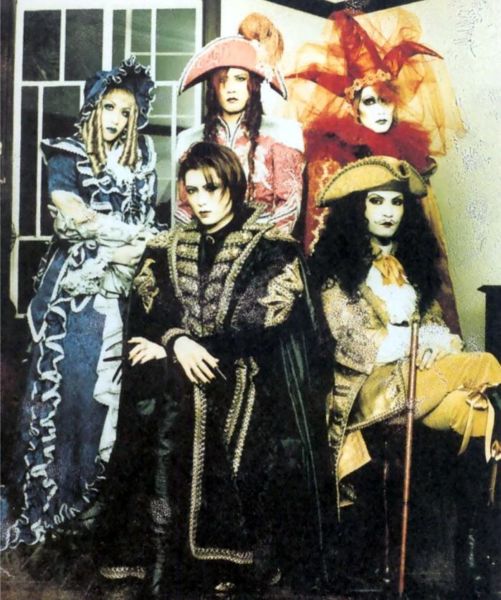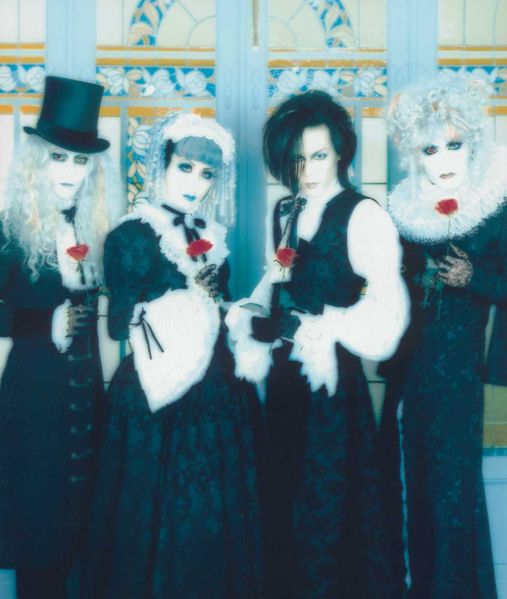
"Rewind the times so crazy..."
What is human? "Nothing but a being of malice and misery" and so they came to be called "Malice Mizer"
Malice Mizer was a Japanese band formed by Mana and Közi in the visual kei music scene, active from August 1992 to December 2001. Their earlier music and themes were characterized by their strong French and classical influences, later moving away from deliberate French romanticism and incorporating Gothic-Victorian aspects after several tragedies befell the band. Despite the stated archetypes, Malice Mizer is best recognized as a thoroughly original entity.
Tetsu Era (1992-1994) Malice Mizer was formed in 1992 by Mana and Közi with Tetsu on vocals, both Mana
and Közi on guitars/synthesizers, Yu~ki on bass and Gaz on drums. Malice Mizer's sound
during the
Tetsu era was a mixture of rock, early 1980s goth, and strong classical influences.
Their first official release was the song "Speed of Desperate" on the 1993 compilation
Brain Trash. Before this, they had released a demo tape called Sans Logique which
contained no vocals. Shortly after the release of Brain Trash, Gaz left the band to
join Kneuklid Romance, while Kneuklid Romance's drummer Kami in turn joined Malice
Mizer. In 1994, the band released their first album, memoire, on Mana's newly
founded Indie music label, Midi:Nette, and shortly after re-released it with an
additional bonus track (Baroque) under the title memoire DX. Only days
later, singer Tetsu left the band. While the exact reasons are unknown, Tetsu
went on to take a different direction in his work. The band's continued use of
his lyrics in songs they continued to perform with later vocalists suggest an amicable
split.
Malice Mizer was formed in 1992 by Mana and Közi with Tetsu on vocals, both Mana
and Közi on guitars/synthesizers, Yu~ki on bass and Gaz on drums. Malice Mizer's sound
during the
Tetsu era was a mixture of rock, early 1980s goth, and strong classical influences.
Their first official release was the song "Speed of Desperate" on the 1993 compilation
Brain Trash. Before this, they had released a demo tape called Sans Logique which
contained no vocals. Shortly after the release of Brain Trash, Gaz left the band to
join Kneuklid Romance, while Kneuklid Romance's drummer Kami in turn joined Malice
Mizer. In 1994, the band released their first album, memoire, on Mana's newly
founded Indie music label, Midi:Nette, and shortly after re-released it with an
additional bonus track (Baroque) under the title memoire DX. Only days
later, singer Tetsu left the band. While the exact reasons are unknown, Tetsu
went on to take a different direction in his work. The band's continued use of
his lyrics in songs they continued to perform with later vocalists suggest an amicable
split.
 In 1995, after a year of inactivity, Malice Mizer recruited Gackt as their new vocalist.
With a new concept created by Mana, the band's music became more progressive and
complex incorporating even stronger classical,electronical and using instruments like
accordion remembering French popular music of the 19th century. Visually, the band
abandoned their 1980s goth look for colourful historical costumes always with a gothic
feel. In 1996, Malice Mizer released their second album, Voyage sans retour.
The band became increasingly popular and in 1997 signed with the major label Nippon
Columbia, where they released a number of successful singles, a short film (Bel Air-Verte
Aile ~Kuuhaku no shunkan no naka de~ de l'image), and, in 1998, their first
and only major label album, merveilles. The band even had their own radio show around
this time. In January 1999, at the height of Malice Mizer's success, Gackt was requested
to leave the band and after a year started a solo career. Malice Mizer left Nippon
Columbia and returned to Mana's Indie music label, Midi:Nette.
In 1995, after a year of inactivity, Malice Mizer recruited Gackt as their new vocalist.
With a new concept created by Mana, the band's music became more progressive and
complex incorporating even stronger classical,electronical and using instruments like
accordion remembering French popular music of the 19th century. Visually, the band
abandoned their 1980s goth look for colourful historical costumes always with a gothic
feel. In 1996, Malice Mizer released their second album, Voyage sans retour.
The band became increasingly popular and in 1997 signed with the major label Nippon
Columbia, where they released a number of successful singles, a short film (Bel Air-Verte
Aile ~Kuuhaku no shunkan no naka de~ de l'image), and, in 1998, their first
and only major label album, merveilles. The band even had their own radio show around
this time. In January 1999, at the height of Malice Mizer's success, Gackt was requested
to leave the band and after a year started a solo career. Malice Mizer left Nippon
Columbia and returned to Mana's Indie music label, Midi:Nette.
A few months after Gackt's departure, drummer Kami died of a subarachnoid hemorrhage on June 21, 1999, leaving behind a handful of songs, which the band eventually released as part of the mini-album/video boxset (Shinwa ~Kami's Memorial Box~ [Shinwa meaning legend or fairytale]). Kami was never replaced; from that point on, Malice Mizer would only use support drummers (namely Shue, who is not shown in the band's later and final music videos, nor credited) and Kami would be credited as "eternal blood relative" on all their future releases.
Klaha Era (2000-2001)
 In the second half of 1999 and the beginning of 2000, Malice Mizer — still without an
official vocalist — released a number of singles and began to work on a new album.
Eventually, they recruited Klaha (real name Masaki Haruna), vocalist of visual kei/
darkwave band Pride of Mind. By then the band had abandoned the lighter pop music
sound of the Gackt era for a dramatic mixture of classical music, gothic/goth
and heavy metal music, and adopted an elaborate funeral Goth look. In the summer
of 2000, they released what would be their last album, Bara no seidou,
followed by a very spectacular and theatrical live show, featuring pyrotechnics,
a choir of veiled nuns and a scaled-down cathedral as stage prop. In 2001, Malice
Mizer starred in a feature length vampire movie, Bara no
konrei ~Mayonaka ni kawashita yakusoku~, and released three more singles:
Gardenia, Beast of Blood, and Garnet ~Kindan no sono e~,
Gardenia and Garnet being of a considerably lighter tone than their previous
album, signifying the start of a new era for the band. Unfortunately, those
few singles were all the world would see of the yet again reborn Malice Mizer, as
the band members decided to go their own separate ways in 2001, leaving disband
messages on their official website, Miroir.
In the second half of 1999 and the beginning of 2000, Malice Mizer — still without an
official vocalist — released a number of singles and began to work on a new album.
Eventually, they recruited Klaha (real name Masaki Haruna), vocalist of visual kei/
darkwave band Pride of Mind. By then the band had abandoned the lighter pop music
sound of the Gackt era for a dramatic mixture of classical music, gothic/goth
and heavy metal music, and adopted an elaborate funeral Goth look. In the summer
of 2000, they released what would be their last album, Bara no seidou,
followed by a very spectacular and theatrical live show, featuring pyrotechnics,
a choir of veiled nuns and a scaled-down cathedral as stage prop. In 2001, Malice
Mizer starred in a feature length vampire movie, Bara no
konrei ~Mayonaka ni kawashita yakusoku~, and released three more singles:
Gardenia, Beast of Blood, and Garnet ~Kindan no sono e~,
Gardenia and Garnet being of a considerably lighter tone than their previous
album, signifying the start of a new era for the band. Unfortunately, those
few singles were all the world would see of the yet again reborn Malice Mizer, as
the band members decided to go their own separate ways in 2001, leaving disband
messages on their official website, Miroir.